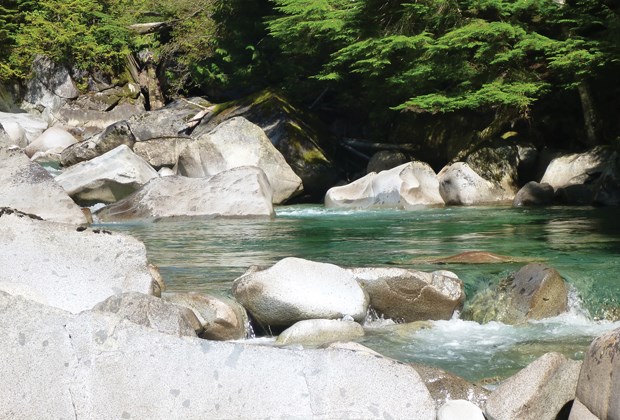A critical salmon habitat and spawning area at the north end of Indian Arm will soon get a boost from a large-scale restoration project.
The Tsleil-Waututh Nation, along with the Department of Fisheries and Oceans, are undertaking habitat restoration in the Indian River watershed. The project is the second venture in the past year. The first was completed last September. Bridget Doyle, environmental stewardship co-ordinator for the Tsleil-Waututh Nation, said work started last year after receiving funding and, along with Fisheries and Oceans Canada, the nation created a program to identify potential priority sites.
"We did a project where we created a huge area of off-channel habitat and spawning habitat within the BC Hydro right-of-way that was otherwise just brush underneath," said Doyle. "And had it connect to the Indian River so that the fish could access it. It's been a really successful project." Since 2012, the Tsleil-Waututh have received
approximately $430,000 for the projects from various sources, including BC Hydro, DFO, Pacific Salmon Foundation and Port Metro, as well as Tsleil-Waututh's own contribution.
Tsleil-Waututh field crews work at least three times a week throughout the year on location. "The majority of our work is maintaining fisheries, enhancing areas and conducting stock assessments on all the stocks that come back every year to the Indian, and we provide that data back to DFO," said Doyle. "But to enhance that and to really re-establish the historic population levels of the salmon, the nation's been wanting to restore the watershed for years and so we finally have been able to start with the more, I guess, focused fish habitats."
Both projects are the first large-scale habitat restoration projects in the area in more than 20 years.
According to Doyle, logging in the watershed decades ago had an impact on the environment. "Forestry roads that were once there started to fail and create all these landslides, so sedimentation in the river became a big issue," she said. "On top of that, BC Hydro put in the huge 5L45 transmission line and FortisBC put in a natural gas pipeline. Although it's remote and relatively untouched from development, there's a lot of utility and infrastructure in there."
Sedimentation from forestry roads was not the only issue; the roads themselves became unsafe to travel, said Doyle.
The Tsleil-Waututh has been working with the various interest groups to mitigate the effects, including road improvements and environmental impacts. The latest project is approximately 2.5 kilometres up from the Indian River estuary, about a 40-minute boat ride from Deep Cove followed by a trek by quad. "Because of all of the impacts to the watershed, the river's quite unstable and it's flashy," said Doyle, adding that around the 1990s the river actually switched course, causing one section to have a straight run.
"It's eroding the banks downstream of the river that are eventually going to cut off this really nice parcel of land that just so happens to hold an ancient foot path and it's at a really important fishing area for Tsleil-Waututh," she said. "It also doesn't create very good fish habitat when it's just this straight run without the natural meander."
Doyle said the project would redirect about a quarter of that flow into the old river channel, re-creating the natural hydrology, as well as adding log jam structures and woody debris to catch wood coming down the river.
"We're trying to create more fish habitat and reduce the downstream erosion to help protect the land and help reduce sedimentation in the river."
After machines left the first project, fish were using it almost immediately, said Doyle. "We had a record run of pink salmon last year, so they were just swarming any type of waterway there was available," she said. "We followed up with a minnow trapping survey this year and there were coho over-wintering in the new habitat, which was really good to see."
Construction is to start Tuesday be completed in one month.



